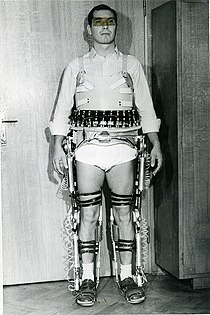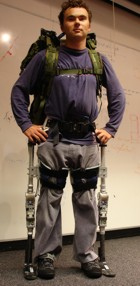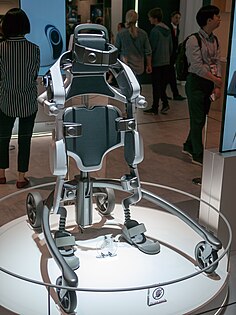Powered exoskeleton
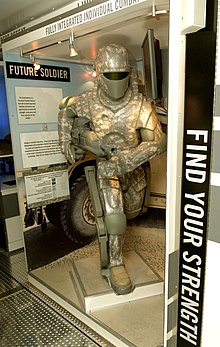
Apowered exoskeleton(also known aspower armor,powered armor,powered suit,cybernetic suit,robot armor,robot suit,high-tech armor,robotic armor,robot armor suit,cybernetic armor,exosuit,hardsuit,exoframeoraugmented mobility[1]) is a mobilemachinethat is wearable over all or part of thehuman body,providingergonomicstructural supportand powered by a system ofelectric motors,pneumatics,levers,hydraulicsor a combination ofcybernetictechnologies, while allowing for sufficientlimbmovement with increased strength and endurance.[2]The exoskeleton is designed to provide bettermechanical loadtolerance, and itscontrol systemaims to sense and synchronize with the user's intended motion and relay the signal to motors which manage the gears. The exoskeleton also protects the user'sshoulder,waist,backandthighagainstoverload,and stabilizes movements when lifting and holding heavy items.[3]
A powered exoskeleton differs from apassive exoskeleton,as the latter has no intrinsicactuatorand relies completely on the user's ownmusclesfor movements, adding more stress and making the user more prone tofatigue,although it does provide mechanical benefits and protection to the user.[4][5]This also explains the difference of an exoskeleton toorthotics,as orthosis mainly aims to promote progressively increased muscle work and, in the best case,regainand improve existing muscle functions. Currently, there are products that can help humans reduce their energy consumption by as much as 60 percent while carrying things.[6]
History
[edit]The earliest-known exoskeleton-like device was an apparatus for assisting movement developed in 1890 by Russian engineer Nicholas Yagin. It used energy stored in compressed gas bags to assist in movement, although it was passive and required human power.[7]In 1917, United States inventor Leslie C. Kelley developed what he called a pedomotor, which operated on steam power with artificialligamentsacting in parallel to the wearer's movements.[8]This system was able to supplement human power with external power.
In the 1960s, the first true 'mobile machines' integrated with human movements began to appear. A suit calledHardimanwas co-developed byGeneral Electricand theUS Armed Forces.The suit was powered by hydraulics and electricity and amplified the wearer's strength by a factor of 25, so that lifting 110 kilograms (240 lb) would feel like lifting 4.5 kilograms (10 lb). A feature called force feedback enabled the wearer to feel the forces and objects being manipulated.
The Hardiman had major limitations, including its 680-kilogram (1,500 lb) weight.[9]It was also designed as a master-slave system: the operator was in a master suit surrounded by the exterior slave suit, which performed work in response to the operator's movements. The response time for the slave suit was slow compared to a suit constructed of a single layer, and bugs caused "violent and uncontrollable motion by the machine" when moving both legs simultaneously.[10]Hardiman's slow walking speed of 0.76 metres per second (2.5 ft/s) further limited practical uses, and the project was not successful.[11]
At about the same time, early active exoskeletons and humanoid robots were developed at theMihajlo Pupin Institutein Yugoslavia by a team led by Prof.Miomir Vukobratović.[12]Legged locomotion systems were developed first, with the goal of assisting in the rehabilitation of paraplegics. In the course of developing active exoskeletons, the Institute also developed theory to aid in the analysis and control of the human gait. Some of this work informed the development of modern high-performance humanoid robots.[13]In 1972, an active exoskeleton for rehabilitation of paraplegics that was pneumatically powered and electronically programmed was tested at Belgrade Orthopedic Clinic.[13]
In 1985, an engineer atLos Alamos National Laboratory(LANL) proposed an exoskeleton called Pitman, a powered suit of armor for infantrymen.[14]The design included brain-scanning sensors in the helmet and was considered too futuristic; it was never built.[15]
In 1986, an exoskeleton called the Lifesuit was designed by Monty Reed, a US Army Ranger who had broken his back in a parachute accident.[16]While recovering in the hospital, he read Robert Heinlein's science fiction novelStarship Troopers,and Heinlein's description of mobile infantry power suits inspired Reed to design a supportive exoskeleton. In 2001, Reed began working full-time on the project, and in 2005 he wore the 12th prototype in the Saint Patrick's Day Dash foot race in Seattle, Washington.[17]Reed claims to have set thespeed recordfor walking in robot suits by completing the 4.8-kilometre (3 mi) race at an average speed of 4 kilometres per hour (2.5 mph).[18]The Lifesuit prototype 14 can walk 1.6 km (1 mi) on a full charge and lift 92 kg (203 lb) for the wearer.[19]
- Some exoskeleton models
Classification
[edit]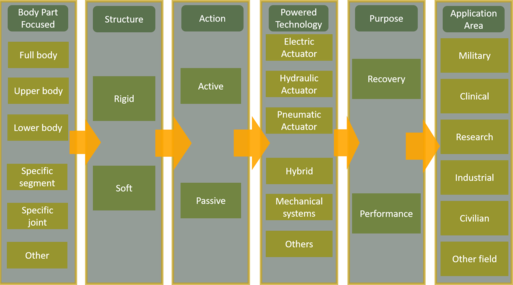
The general categorization suggests several feasible exoskeleton categories. Such categories have general classes, due to the wide quantity of exoskeletons in existence, and are the structure, the body part focused on, the action, the power technology, the purpose, and the application area varying from one to another.[20]
Exoskeletons are not only designed for specific body parts; the exoskeletons may be designed more generally for only one hand, a leg, or even the complete body. Thus, the separation of the classes demonstrates the most common body parts exoskeletons can be built for. The full-body class refers to the exoskeletons made to assist all the limbs, or most of the body. The upper body refers to the exoskeletons made for the upper limbs, and involving the chest, head, back, and/or shoulders. The lower body category refers to the exoskeletons made for the lower limbs: thighs, lower legs, and/or hips. Moreover, there are classes for specific limbs and specific joints. These classes include exoskeletons designed for the knee, ankle, hand, arm, foot, etc. Additionally, there is a special class for any other exoskeleton that is not included in the previous classes.[20]
Rigid exoskeletons are those whose structural components attached to the user’s body are made with hard materials. Such materials include metals, plastics, fibers, etc.Soft exoskeletons,also called exo-suits, are instead made with materials that allow free movement of the structural components. Exo-suits are often made with, yet not restricted to, textiles.[20]
The action category describes the type of help the exoskeleton gives the user, dividing exoskeletons into active and passive action. The active class comprises exoskeletons that give “active” aid to the user; in other words, these exoskeletons perform the movements without the need for the user to apply energy. The energy needed to perform the movement is supplied by an external source. On the other hand, the passive class comprises exoskeletons that need the user to perform the movement to work; these exoskeletons do not have power sources. Thus, the user has to perform the movement, and while doing it, the exoskeleton facilitates the movement.[20]
The powered technologies are separated into four main classes, with one specific class for hybrid and one for any other non-common power technology. The four main classes comprise the electric, hydraulic, and pneumatic actuators as the active action, and the mechanical systems as the passive action.[20]
The exoskeleton’s purpose defines what the exoskeleton will be used for. This category has only two classes: recovery and performance. The recovery exoskeletons are used for rehabilitation; the performance exoskeletons are used for assistance.[20]
The last category comprises the application area for which the exoskeleton was made. Each exoskeleton may belong to one or more class. The military class comprises any exoskeleton used for any activity involving an army, navy, airforce, or any other military branch. The medical class comprises the exoskeletons involved in clinical activities, or in general, used in any hospital/clinic. Additionally, the recovery exoskeletons are normally classified in the medical class. Furthermore, the research class comprises the exoskeletons that are nowadays in their research development phase. The industrial class, as its name suggests, encompasses those exoskeletons made specifically for industrial activities. These exoskeletons are characterized for being used by people without any pathology seeking the avoidance of long-term physical damages. This description also applies to military exoskeletons. The civilian class is for the recovery or performance exoskeletons made for people to use in their homes or public spaces, aiding in tasks that people cannot perform as easily alone. Finally, there is a class for exoskeletons in which the applications do not fit into any of the previous classes.[20]
Applications
[edit]
Medical
[edit]In medical application, e.g. with complete paraplegia afterspinal cord injury,an exoskeleton can be an additional option for the supply of aids if the structural and functional properties of the neuromuscular and skeletal system are too limited to be able to achieve mobilization with anorthosis.In patients with complete paraplegia(ASIA A),exoskeletons are interesting as an alternative to an orthosis under this criterion for lesion heights above the thoracic vertebra (T12). In patients with incomplete paraplegia(ASIA B-D),orthoticsare even suitable for lesion heights above T12 in order to promote the patient's own activity to such an extent that the therapeutical mobilization can be successful.[21][22][23]In contrast to an orthosis, an exoskeleton takes over a large part of the active muscle work, while anorthosisis intended to activate the recovery of muscle work. In addition powered exoskeletons can improve the quality of life of individuals who have lost the use of their legs by enabling system-assisted walking.[24]Exoskeletons—that may be called "step rehabilitation robots" —may also help with the rehabilitation fromstroke,spinal cord injuryor during aging.[25]Several prototype exoskeletons are under development.[26][27]The Ekso GT, made by Ekso Bionics, is the first exoskeleton to be approved by the US Food and Drug Administration (FDA) for stroke patients.[28]TheGerman Research Centre for Artificial Intelligencehas developed two general purpose powered exoskeletons, CAPIO[29][30]and VI-Bot.[31]These are primarily being used for teleoperation. Exoskeleton technology is also being developed to enhance precision during surgery,[32]and to help nurses move and carry heavy patients.[33]
Military
[edit]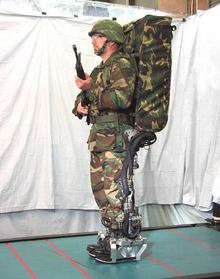
Developing a full-body suit that meets the needs of soldiers has proven challenging. The Defense Advanced Research Projects Agency (DARPA) launched the Warrior Web program[34]in September 2011[35]and has developed and funded several prototypes, including a "soft exosuit" developed byHarvard University'sWyss Institute.[36]In the early 2000s, DARPA funded the firstSarcosfull-body, powered exoskeleton prototype, which was hydraulically actuated and consumed 6,800 watts of power.[37]By 2010, DARPA and Sarcos had more than halved that, to 3,000 watts, but still required the exoskeleton to be tethered to the power source. Nowadays, the Sarcos Guardian XO is powered by lithium-ion batteries and is applicable for military logistics applications.[37]In 2019, the US Army'sTALOSexoskeleton project was put on hold.[38]A variety of "slimmed-down" exoskeletons have been developed for use on the battlefield, aimed at decreasing fatigue and increasing productivity.[39]For example,Lockheed Martin's ONYX suit aims to support soldiers in performing tasks that are "knee-intensive", such as crossing difficult terrain.[40]Leia Stirling's group has identified that exoskeletons can reduce a soldier's response times.[41]
Civilian
[edit]Exoskeletons are being developed to help firefighters and other rescue workers to climb stairs while carrying heavy equipment.[42]
Industry
[edit]Passive exoskeleton technology is increasingly being used in the automotive industry, with the goal of reducing worker injury (especially in the shoulders and spine) and reducing errors due to fatigue.[43][44]They are also being examined for use inlogistics.[45]
These systems can be divided into two categories:[46]
- exoskeletons for upper-limb for assisting shoulder flexion-extension movements;
- exoskeletons for lumbar support for assisting manual lifting tasks.
For its application in the broadest sense, industrial exoskeletons must be lightweight, comfortable, safe, and minimally disruptive to the environment.[47]For some applications, single-joint exoskeletons (i.e. intended to assist only the limb involved in specific tasks) are more appropriate than full-body powered suits.[47]Full-body powered exoskeletons have been developed to assist with heavy loads in the industrial setting,[48][49]and for specialized applications such as nuclear power plant maintenance.[50]
The biomechanical efficacy of exoskeletons in industrial applications is however still largely unknown. Companies have to conduct a risk assessment for workplaces at which exoskeletons are to be used. TheInstitute for Occupational Safety and Health of the German Social Accident Insurancehas developed a draft risk assessment for exoskeletons and their use. The safety assessment is based on diverse experience including machine safety, personal protective equipment and risk analysis of physical stresses at work. The exoskeletons available on the market often fail to give adequate consideration to safety aspects, in some cases despite claims to the contrary by their manufacturers.[51]
Products
[edit]- Japet Exoskeleton is a powered lower-back exoskeleton for work and industry based on established passive braces. It is intended to reduce lumbar pressure.[52]
- Parker Hannifin's Indego Exoskeleton is an FDA-Cleared, electrically powered support system for legs that helps spinal cord injury patients and stroke patients walk.[53][54]
- ReWalkfeatures powered hip and knee motion to enable those with lower limb disabilities, including paraplegia as a result of spinal cord injury (SCI), to perform self-initiated standing, walking, and stair ascending and descending.[55]ReStore, a simpler system by the same manufacturer, attaches to a single leg to assist with gait retraining, and was approved by the FDA in 2019.[55]
- Ekso Bionics's EskoGT is a hydraulically powered exoskeleton system allowing paraplegics to stand and walk with crutches or a walker.[56]It was approved by the FDA in 2019.[28]
- SuitX's Phoenix is a modular, light and cheap exoskeleton, powered by a battery backpack that allows paraplegics to walk at up to 1.8 kilometres per hour (1.1 mph).[57]
- Cyberdyne'sHALis a wearable robot that comes in multiple configurations.[58]HAL is currently in use in Japanese and US hospitals and was given global safety certification in 2013.[27][59]
- Honda's Walking Assist Device is a partial exoskeleton to help those with difficulties walking unsupported. It was given pre-market notification by the FDA in 2019.[60]
- TheEuropean Space Agencyhas developed a series of ergonomic exoskeletons for robotic teleoperation, including the EXARM, X-Arm-2 and SAM exoskeletons. The target application is telemanipulation of astronaut-like robots, operating in a remote harsh environment.[61]
- In 2018, Spanish exoskeleton provider Gogoa Mobility was the first European company to get a CE approval for their powered lower body HANK exoskeleton for medical use.[62]The CE approval covered the use of HANK for rehabilitation due to Spinal Cord Injury (SCI), Acquired Brain Damage (ABD) & Neurodegenerative Illnesses. In Feb 2020, their knee specific exoskeleton called Belk also received a CE approval.
- Roam Robotics produces a soft exoskeleton for skiers and snowboarders.[63]
- Wandercraft produces Atalante, the first powered exoskeleton to allow users to walk hands-free, unlike most powered medical exoskeleton that require the simultaneous use of crutches.[64]
- Sarcoshas unveiled a full-body, powered exoskeleton, the Guardian XO, which can lift up to 200 pounds (91 kg).[65][66]Their "Alpha" version was demonstrated at the 2020 Consumer Electronics Show withDelta Air Lines.[67]
- ExoMed's ExoHeaver is electrically powered exoskeleton, designed for Russiannickelandpalladiumminingandsmeltingcompany in 2018. Designed for lifting and holding loads weighing up to 60 kg (130 lb) and collecting information about the environment using sensors. More than 20 exoskeletons have been tested and are used at the enterprise.[68]
- Comauintroduced a passive spring-loaded exoskeleton called the Comau MATE which provides antigravitational support to the user. The exosuit supports the upper arms and spine to help facilitate work and reduce physicalfatigue.MATE’s spring-loaded actuation box stores energy through an advanced mechanism during the extension phase, and then returns it to the user during the flexion phase.[69]
Projects on hold/abandoned
[edit]- Lockheed Martin'sHuman Universal Load Carrier(HULC) was abandoned after tests showed that wearing the suit caused users to expend significantly more energy during controlled treadmill walks.[70]
- TheBerkeley Lower Extremity Exoskeleton(BLEEX) consisted of mechanical metal leg braces, a power unit, and a backpack-like frame to carry a heavy load.[71]The technology developed for BLEEX led to SuitX's Phoenix.[72]
- A project fromGhent University,WALL-X was shown in 2013 to reduce the metabolic cost of normal walking. This result was achieved by optimizing the controls based on the study of thebiomechanicsof the human-exoskeleton interaction.[73]
Limitations and design issues
[edit]Mobility aids are frequently abandoned for lack of usability.[74]Major measures of usability include whether the device reduces the energy consumed during motion, and whether it is safe to use. Some design issues faced by engineers are listed below.
Power supply
[edit]One of the biggest problems facing engineers and designers of powered exoskeletons is thepower supply.[75]This is a particular issue if the exoskeleton is intended to be worn "in the field", i.e. outside a context in which the exoskeleton can be tethered to external power sources viapower cables,thus having to rely solely on onboard power supply.Battery packswould require frequent replacement or recharging,[75]and may risk explosion due tothermal runaway.[76]According to Sarcos, the company has solved some of these issues related to battery technology, particularly consumption, reducing the amount of power required to operate its Guardian XO to under 500 watts (0.67 hp) and enabling its batteries to be "hot-swapped" without powering down the unit.[37]Internal combustion engineoffer high energy output, but problems include exhaust fumes,waste heatand inability to modulate power smoothly,[77]as well as the periodic need to replenish volatilefuels.Hydrogen cellshave been used in some prototypes[78]but also suffer from several safety problems.[79]
Skeleton
[edit]Early exoskeletons used inexpensive and easy-to-mold materials such assteelandaluminium alloy.However, steel is heavy and the powered exoskeleton must work harder to overcome its own weight, reducing efficiency. Aluminium alloys are lightweight, but fail throughfatiguequickly.[80]Fiberglass,carbon fiberandcarbon nanotubeshave considerably higher strength per weight.[81]"Soft" exoskeletons that attach motors and control devices to flexible clothing are also under development.[82]
Actuators
[edit]
Jointactuatorsalso face the challenge of being lightweight, yet powerful. Technologies used include pneumatic activators,[63]hydraulic cylinders,[83]and electronicservomotors.[84]Elastic actuators are being investigated to simulatecontrol of stiffnessin human limbs and provide touch perception.[85]Theair muscle,a.k.a.braided pneumatic actuator or McKibben air muscle, is also used to enhance tactile feedback.[86]
Joint flexibility
[edit]Theflexibilityofhuman anatomyis a design issue for traditional "hard" robots. Several human joints such as thehipsandshouldersareball and socket joints,with the center of rotation inside the body. Since no two individuals are exactly alike, fully mimicking thedegrees of freedomof a joint movement is not possible. Instead, the exoskeleton joint is commonly modeled as a series ofhingeswith one degree of freedom for each axis of rotations.[74]
Spinalflexibility is another challenge since the spine is effectively a stack of limited-motion ball joints. There is no simple combination of external single-axis hinges that can easily match the fullrange of motionof thehuman spine.Because accurate alignment is challenging, devices often include the ability to compensate for misalignment with additional degrees of freedom.[87]
Soft exoskeletons bend with the body and address some of these issues.[88]
Power control and modulation
[edit]A successful exoskeleton should assist its user, for example by reducing the energy required to perform a task.[74]Individual variations in the nature, range and force of movements make it difficult for a standardized device to provide the appropriate amount of assistance at the right time. Algorithms to tune control parameters to automatically optimize the energy cost of walking are under development.[89][90]Direct feedback between thehuman nervous systemand motorized prosthetics ( "neuro-embodied design" ) has also been implemented in a few high-profile cases.[91]
Adaptation to user size variations
[edit]Humans exhibit a wide range of physical size differences in both skeletal lengths and limb and torso girth, so exoskeletons must either be adaptable or fitted to individual users. In military applications, it may be possible to address this by requiring the user to be of an approved physical size in order to be issued an exoskeleton. Physical body size restrictions already occur in the military for jobs such as aircraft pilots, due to the problems of fitting seats and controls to very large and very small people.[92]For soft exoskeletons, this is less of a problem.[88]
Health and safety
[edit]While exoskeletons can reduce the stress of manual labor, they may also pose dangers.[1]The USCenters for Disease Control and Prevention(CDC) has called for research to address the potential dangers and benefits of the technology, noting potential new risk factors for workers such as lack of mobility to avoid a falling object, and potential falls due to a shift in center of gravity.[93]
As of 2018, the USOccupational Safety and Health Administrationhas not prepared any safety standards for exoskeletons. TheInternational Organization for Standardizationpublished a safety standard in 2014, andASTM Internationalwas working on standards to be released beginning in 2019.[1]
Major events
[edit]- Cybathlon:an international competition in which people with physical disabilities compete against each other to complete everyday tasks using state-of-the-art technical assistance systems.[94]
Fictional depictions
[edit]Powered exoskeletons are featured inscience fictionbooks and media as the standard equipment forspace marines,miners, astronauts and colonists. The science fiction novelStarship TroopersbyRobert A. Heinlein(1959) is credited with introducing the concept of futuristic military armor. Other examples includeTony Stark'sIron Mansuit, the robot exoskeleton used byEllen Ripleyto fight theXenomorphqueen inAliens,inWarhammer 40,000theSpace Marines,among other factions, are known to use different kinds of Power Armour,[95]thePower Armorused in theFalloutvideo gamefranchise and the Exoskeleton fromS.T.A.L.K.E.R.[96][97][98]
See also
[edit]- Affusto d'assalto/bari mount
- Atmospheric diving suit– Articulated pressure resistant anthropomorphic housing for an underwater diver
- Back brace– Corrective medical device worn around a patient's back
- Bionics– Application of natural systems to technology
- Future Force Warrior
- List of emerging technologies
- Mecha
- Steadicam– Motion picture camera stabilizer mounts
- TAWIS
- Walking Truck,experimental quadrupedal vehicle; also known as the "Cybernetic Anthropomorphous Machine"
References
[edit]- ^abcFerguson, Alan (September 23, 2018)."Exoskeletons and injury prevention".Safety+Health Magazine.RetrievedOctober 19,2018.
- ^Blake McGowan (2019-10-01)."Industrial Exoskeletons: What You're Not Hearing".Occupational Health & Safety.Retrieved2018-10-10.
- ^Li, R.M.; Ng, P.L. (2018)."Wearable Robotics, Industrial Robots and Construction Worker's Safety and Health".Advances in Human Factors in Robots and Unmanned Systems.Advances in Intelligent Systems and Computing. Vol. 595. pp. 31–36.doi:10.1007/978-3-319-60384-1_4.ISBN9783319603834.
- ^Koopman, Axel S.; Kingma, Idsart; Faber, Gert S.; de Looze, Michiel P.; van Dieën, Jaap H. (23 January 2019)."Effects of a passive exoskeleton on the mechanical loading of the low back in static holding tasks"(PDF).Journal of Biomechanics.83:97–103.doi:10.1016/j.jbiomech.2018.11.033.ISSN0021-9290.PMID30514627.S2CID54484633.
- ^Bosch, Tim; van Eck, Jennifer; Knitel, Karlijn; de Looze, Michiel (1 May 2016). "The effects of a passive exoskeleton on muscle activity, discomfort and endurance time in forward bending work".Applied Ergonomics.54:212–217.doi:10.1016/j.apergo.2015.12.003.ISSN0003-6870.PMID26851481.
- ^Bogue, Robert (2022-06-30)."Exoskeletons: a review of recent progress".Industrial Robot.49(5): 813–818.doi:10.1108/IR-04-2022-0105.ISSN0143-991X.S2CID248640941.
- ^Yagin, Nicholas. "Apparatus for Facilitating Walking".U.S. patent 440,684filed February 11, 1890 and issued November 18, 1890.
- ^Kelley, C. Leslie. "Pedomotor".U.S. patent 1,308,675filed April 24, 1917 and issued July 1, 1919.
- ^"Final Report On Hardiman I Prototype For Machine Augmentation Of Human Strength And Endurance"(PDF).Defense Technical Information Center.August 30, 1971. Archived fromthe original(PDF)on July 6, 2019.RetrievedJuly 5,2019.
- ^Keller, Mike (August 25, 2016)."Do You Even Lift, Bro? Hardiman Was GE's Muscular Take On The Human-Machine Interface".GE Reports.RetrievedJuly 6,2019.
- ^Bellis, Mary."Exoskeletons for Human Performance Augmentation".ThoughtCo.Retrieved2016-02-20.
- ^Baldovino, Renann; Jamisola, Rodrigo Jr. (2017)."A survey in the different designs and control systems of powered-exoskeleton for lower extremities"(PDF).Journal of Mechanical Engineering and Biomechanics, Rational Publication.1(4): 103–115.doi:10.24243/JMEB/1.4.192(inactive 2024-06-09).
{{cite journal}}:CS1 maint: DOI inactive as of June 2024 (link) - ^abVukobratovic, Miomir K. (February 7, 2017)."When Were Active Exoskeletons Actually Born?"(PDF).Robotics Laboratory.RetrievedJune 8,2019.
- ^Hecht, Jeff (1986-09-25).Armour-suited warriors of the future.Issue 1527: New Scientist. p. 31.
{{cite book}}:CS1 maint: location (link) - ^Pope, Gregory T. (December 1, 1992)."Power Suits".Discover Magazine.RetrievedJuly 4,2019.
- ^"Giving the Gift of Walking – a 501 C3 nonprofit".They Shall Walk. 2013-01-24.Retrieved2016-02-20.
- ^Richman, Dan (March 11, 2005)."Man's dream is that Lifesuit will help paralyzed walk again".Seattle Post-Intelligencer.RetrievedJuly 4,2019.
- ^Reed, Monty K. (January 21, 2011)."Paralyzed Man Walks Again: Thanks to LIFESUIT prototype".They Shall Walk.RetrievedJuly 4,2019.
- ^Monty K Reed (October 10, 2014). "LIFESUIT Exoskeleton Gives the Gift of Walking so They Shall Walk".IEEE Global Humanitarian Technology Conference (GHTC 2014).IEEE. pp. 382–385.doi:10.1109/GHTC.2014.6970309.ISBN9781479971930.S2CID35922757.
- ^abcdefghde la Tejera, Javier A.; Bustamante-Bello, Rogelio; Ramirez-Mendoza, Ricardo A.; Izquierdo-Reyes, Javier (24 December 2020)."Systematic Review of Exoskeletons towards a General Categorization Model Proposal".Applied Sciences.11(1): 76.doi:10.3390/app11010076.
 Text was copied from this source, which is available under aCreative Commons Attribution 4.0 International License.
Text was copied from this source, which is available under aCreative Commons Attribution 4.0 International License.
- ^James W. Rowland, Gregory W. J. Hawryluk."Current status of acute spinal cord injury pathophysiology and emerging therapies: promise on the horizon".JNS Journal of Neurosurgery.25:2, 6.[dead link]
- ^Burns, Anthony S.; Ditunno, John F. (15 December 2001)."Establishing Prognosis and Maximizing Functional Outcomes After Spinal Cord Injury: A Review of Current and Future Directions in Rehabilitation Management".Spine.26(24S): S137-45.doi:10.1097/00007632-200112151-00023.ISSN0362-2436.PMID11805621.S2CID30220082.
- ^Kirshblum, Steven C.; Priebe, Michael M. (March 2007)."Spinal Cord Injury Medicine. 3. Rehabilitation Phase After Acute Sinap CordInjury".Spinal Cord Injury Medicine.88.Retrieved6 August2021.
- ^Ashley, Steven (February 21, 2017)."Robotic exoskeletons are changing lives in surprising ways".NBC News.RetrievedJuly 4,2019.
- ^"One step at a time: Rehabilitation robots that will keep 'elderly' mobile".The Express Tribune.Reuters. April 12, 2017.RetrievedJuly 4,2019.
- ^Moore, Elizabeth Armstrong (March 15, 2011)."HAL-5: The exoskeleton robot 'to suit you'".CNET.RetrievedJuly 4,2019.
- ^abOsbun, Ashley (February 8, 2019)."Patients Walk Again with the HAL Exoskeleton".Electronic Component News.RetrievedJuly 5,2019.
- ^abStrickland, Eliza (September 30, 2016)."Demo: The Ekso GT Robotic Exoskeleton for Paraplegics and Stroke Patients".IEEE Spectrum.RetrievedJuly 4,2019.
- ^Dormehli, Luke (November 15, 2016)."Wearable exoskeleton lets researchers in Russia control a robot in Germany".Digital Trends.RetrievedJuly 4,2019.
- ^"Capio".Robotics Innovation Center—DFKI. 2013-12-31.Retrieved2016-02-08.
- ^"VI-Bot".Robotics Innovation Center—DFKI. 2010-12-31.Retrieved2016-02-08.
- ^Franco, Michael (March 15, 2017)."Hand-mounted exoskeleton system helps surgeons get a grip".New Atlas.RetrievedJuly 4,2019.
- ^Gilhooly, Rob (17 June 2012)."Exoskeletons await in work/care closet".The Japan Times Online.Retrieved21 August2013.
- ^"Warrior Web".Defense Advanced Research Projects Agency.RetrievedJuly 4,2019.
- ^RBR Staff (2015-02-21)."Ekso Selected to Participate in Warrior Web Task B".Robotics Business Review.Retrieved2018-09-04.
- ^Kusek, Kristen (September 11, 2014)."The $3 million suit".Harvard Gazette.RetrievedJuly 5,2019.
- ^abcFreedberg, Sydney J Jr. (March 18, 2019)."SOCOM Tests Sarcos Exoskeleton (No, It Isn't 'Iron Man')".Breaking Defense.RetrievedMarch 10,2021.
- ^Egozi, Arie (May 24, 2019)."SOCOM's Iron Man Must Die, So Iron Man Spinoffs Might Live".Breaking Defense.RetrievedJuly 4,2019.
- ^Adams, Eric (June 28, 2018)."Power-multiplying exoskeletons are slimming down for use on the battlefield".Popular Science.RetrievedJuly 4,2017.
- ^Santana, Marco (January 4, 2019)."Lockheed Martin shows off Orlando-built exoskeleton tech for U.S. Army".Orlando Sentinel.RetrievedJuly 4,2019.
- ^"Leia Stirling leads study on exoskeletons and decision making".Harvard-MIT Health Sciences and Technology.October 4, 2018.RetrievedJuly 24,2019.
- ^Ridden, Paul (April 18, 2018)."Auberon exoskeleton takes the strain out of firefighting in towering infernos".New Atlas.RetrievedJuly 4,2019.
- ^Marinov, Borislav (May 15, 2019)."Passive Exoskeletons Establish A Foothold In Automotive Manufacturing".Forbes.RetrievedJuly 5,2019.
- ^Stuart, S. C. (June 18, 2018)."Checking Out Ford's Factory Floor Exoskeletons".PC Magazine.RetrievedJuly 5,2019.
- ^"Exoskeletons for Logistics".VIL.Retrieved16 January2020.
- ^Spada, Stefania; Ghibaudo, Lidia; Gilotta, Silvia; Gastaldi, Laura; Cavatorta, Maria Pia (1 July 2018)."Analysis of Exoskeleton Introduction in Industrial Reality: Main Issues and EAWS Risk Assessment".Advances in Physical Ergonomics and Human Factors.Advances in Intelligent Systems and Computing. Vol. 602. pp. 236–244.doi:10.1007/978-3-319-60825-9_26.ISBN9783319608242.ISSN2194-5357.
- ^abVoilqué, Anthony; Masood, Jawad; Fauroux, J.C.; Sabourin, Laurent; Guezet, Olivier (March 25, 2019). "Industrial Exoskeleton Technology: Classification, Structural Analysis, and Structural Complexity Indicator".2019 Wearable Robotics Association Conference (WearRAcon).pp. 13–20.doi:10.1109/WEARRACON.2019.8719395.ISBN97815386-80568.S2CID169037039.
- ^Looze, Michiel P. de; Bosch, Tim; Krause, Frank; Stadler, Konrad S.; O’Sullivan, Leonard W. (May 3, 2016)."Exoskeletons for industrial application and their potential effects on physical work load".Ergonomics.59(5): 671–681.doi:10.1080/00140139.2015.1081988.hdl:10344/5646.ISSN0014-0139.PMID26444053.S2CID1135619.
- ^Haridy, Rich (January 3, 2019)."Battery-powered, full-body exoskeleton lets users lift 200 pounds".New Atlas.RetrievedJuly 4,2019.
- ^Hornyak, Tim (June 2, 2014)."Panasonic's robotic exoskeletons could help nuclear plant workers".Computerworld.RetrievedJuly 5,2019.
- ^"Exoskeletons".IFA.Deutsche Gesetzliche Unfallversicherung.Retrieved15 June2020.
- ^Moulart, Mélissa; Olivier, Nicolas; Giovanelli, Yonnel; Marin, Frédéric (1 November 2022)."Subjective assessment of a lumbar exoskeleton's impact on lower back pain in a real work situation".Heliyon.8(11): e11420.Bibcode:2022Heliy...811420M.doi:10.1016/j.heliyon.2022.e11420.ISSN2405-8440.PMC9678677.PMID36425419.S2CID253449651.
- ^Alexander, Dan (15 April 2015)."Innovation Factory: How Parker Hannifin Pumps Out Breakthrough Products".Forbes.Retrieved21 June2017.
- ^Freeman, Danny (July 1, 2019)."Exoskeleton Device Donated to San Diego VA Will Help Rehabbing Vets".NBC 7 San Diego.RetrievedJuly 5,2019.
- ^abFanning, Paul (October 11, 2012)."Bionic exoskeleton could transform lives of paraplegics".Eureka!.RetrievedJuly 5,2019.
- ^Jacobs, Melissa (May 2019)."Through the Help of a Robotic Exoskeleton, a Collegeville Man Gets a Chance to Walk Again".Main Line Today.RetrievedJuly 5,2019.
- ^Brewster, Signe (February 1, 2016)."This $40,000 Robotic Exoskeleton Lets the Paralyzed Walk".MIT Technology Review.RetrievedJuly 7,2019.
- ^Maloney, Dan (January 28, 2019)."The Cyborgs Among Us: Exoskeletons Go Mainstream".Hackaday.RetrievedJuly 7,2019.
- ^"Japan's Robot Suit Gets Global Safety Certificate".IndustryWeek.Agence France-Presse. 27 February 2013.Retrieved25 October2017.
- ^Davies, Chris (January 10, 2019)."Honda's exoskeleton is one (assisted) step closer to launch".SlashGear.RetrievedJuly 5,2019.
- ^"The ESA Exoskeleton".European Space Agency.RetrievedJuly 5,2019.
- ^"Gogoa Mobility Robots announces CE Mark Approval for HANK Exoskeleton".Business Insider.22 October 2018.Retrieved5 August2020.
- ^abAckerman, Evan (March 6, 2018)."Roam Robotics Announces $2500 Soft Exoskeleton For Skiers and Snowboarders".IEEE Spectrum.RetrievedJuly 6,2019.
- ^Dent, Steve (27 September 2017)."Wandercraft's exoskeleton was made to help paraplegics walk".Engadget.Retrieved4 March2020.
- ^Salter, Jim (22 January 2020)."Sarcos offers fully mobile, insanely strong industrial exoskeletons".Ars Technica.Retrieved6 April2021.
- ^Maronov, Bobby (10 December 2019)."Guardian XO Alpha: Up Close and Personal with the Sarcos Robotics Full-Body Powered Exoskeleton".Exoskeleton Report.Retrieved6 April2021.
- ^German, Kent; Collins, Katie (7 January 2020)."Delta reveals exoskeletons, free Wi-Fi and a binge button at CES 2020".CNET.Retrieved6 April2021.
- ^"«Норникель» выпустит интеллектуальную версию экзоскелета - Норникель".www.nornickel.ru.Retrieved2022-10-06.
- ^"Comau MATE".Comau.RetrievedMarch 3,2022.
- ^Cornwall, Warren (October 15, 2015)."Feature: Can we build an 'Iron Man' suit that gives soldiers a robotic boost?".American Association for the Advancement of Science.RetrievedJuly 5,2019.
- ^Yang, Sarah (March 3, 2004)."UC Berkeley researchers developing robotic exoskeleton that can enhance human strength and endurance".University of California, Berkeley.RetrievedJuly 4,2019.
- ^Affairs, Public; Berkeley, U. C. (February 4, 2016)."UC Berkeley exoskeleton helps the paralyzed to walk".University of California.RetrievedJuly 5,2019.
- ^Malcolm, Philippe; Derave, Wim; Galle, Samuel; De Clercq, Dirk; Aegerter, Christof Markus (13 February 2013)."A Simple Exoskeleton That Assists Plantarflexion Can Reduce the Metabolic Cost of Human Walking".PLOS ONE.8(2): e56137.Bibcode:2013PLoSO...856137M.doi:10.1371/journal.pone.0056137.PMC3571952.PMID23418524.
- ^abcNäf, Matthias B.; Junius, Karen; Rossini, Marco; Rodriguez-Guerrero, Carlos; Vanderborght, Bram; Lefeber, Dirk (September 1, 2018)."Misalignment Compensation for Full Human-Exoskeleton Kinematic Compatibility: State of the Art and Evaluation".Applied Mechanics Reviews.70(5): 050802.Bibcode:2018ApMRv..70e0802N.doi:10.1115/1.4042523.ISSN0003-6900.
- ^abMeeting the Energy Needs of Future Warriors.National Academies Press. 31 August 2004. p. 40.ISBN9780309165761.Retrieved18 February2016.
- ^Liebscher, Alysha; Gayman, Gary (December 26, 2018)."Preventing Thermal Runaway in Electric Vehicle Batteries".Machine Design.RetrievedJuly 5,2019.
- ^Yellow Magpie (May 1, 2013)."Exoskeleton Suit Problems That Need To Be Overcome".Yellow Magpie.RetrievedJuly 5,2019.
- ^Kantola, Kevin (January 26, 2010)."HULC Robotic Exoskeleton Powered by Hydrogen Fuel Cell".Hydrogen Cars Now.RetrievedJuly 5,2019.
- ^"Hydrogen Storage Challenges".Energy.gov.RetrievedJuly 7,2019.
- ^Frumento, Christopher; Messier, Ethan; Montero, Victor (2010-03-02)."History and Future of Rehabilitation Robotics"(PDF).Worchetser Polytechnic Institute.Retrieved2016-02-20.
- ^Kerns, Jeff (January 8, 2015)."The Rise of the Exoskeletons".Machine Design.RetrievedJuly 6,2019.
- ^Heater, Brian (July 18, 2017)."ReWalk Robotics shows off a soft exosuit designed to bring mobility to stroke patients".TechCrunch.RetrievedJuly 6,2019.
- ^"Military exoskeletons uncovered: Ironman suits a concrete possibility".Army Technology.January 29, 2012.RetrievedJuly 6,2019.
- ^Ferris, Daniel P.; Schlink, Bryan R.; Young, Aaron J. (2019-01-01), "Robotics: Exoskeletons", in Narayan, Roger (ed.),Encyclopedia of Biomedical Engineering,Elsevier, pp. 645–651,ISBN9780128051443
- ^Siegel, R. P. (April 8, 2019)."Robotic Fingers Are Learning How to Feel".Design News.RetrievedJuly 6,2019.
- ^"Glove powered by soft robotics to interact with virtual reality environments".ScienceDaily.May 30, 2017.RetrievedJuly 6,2019.
- ^Näf, Matthias B.; Koopman, Axel S.; Baltrusch, Saskia; Rodriguez-Guerrero, Carlos; Vanderborght, Bram; Lefeber, Dirk (June 21, 2018)."Passive Back Support Exoskeleton Improves Range of Motion Using Flexible Beams".Frontiers in Robotics and AI.5:72.doi:10.3389/frobt.2018.00072.ISSN2296-9144.PMC7805753.PMID33500951.
- ^abDavis, Steve (June 26, 2016)."Forget Iron Man: skintight suits are the future of robotic exoskeletons".The Conversation.RetrievedJuly 7,2019.
- ^Collins, Steve (June 22, 2017)."Exoskeletons Don't Come One-Size-Fits-All... Yet".Wired.RetrievedJuly 8,2019.
- ^Arbor, Ann (June 5, 2019)."Open-source bionic leg: First-of-its-kind platform aims to rapidly advance prosthetics".University of Michigan News.RetrievedJuly 8,2019.
- ^Wakefield, Jane (July 8, 2018)."Exoskeletons promise superhuman powers".BBC.RetrievedJuly 8,2019.
- ^Cote, David O.; Schopper, Aaron W. (1984-07-01)."Anthropometric Cockpit Compatibility Assessment of US Army Aircraft for Large and Small Personnel Wearing a Cold Weather, Armored Vest, Chemical Defense Protective Clothing Configuration"(PDF).Defense Technical Information Center.Archived(PDF)from the original on March 2, 2016.Retrieved2016-02-20.
- ^Zingman, Alissa; Earnest, G. Scott; Lowe, Brian D.; Branche, Christine M. (June 15, 2017)."Exoskeletons in Construction: Will they reduce or create hazards?".Centers for Disease Control and Prevention.RetrievedJuly 8,2017.
- ^"About CYBATHLON".CYBATHLON.Retrieved1 September2020.
- ^Gonzalez, Oscar (2019-09-25)."Fallout Power Armor helmet recalled due to mold".CNET.Retrieved2020-10-30.
- ^Liptak, Andrew (December 10, 2017)."18 suits of power armor from science fiction you don't want to meet on the battlefield".The Verge.
- ^Matulef, Jeffrey (2016-01-23)."Fallout 4 14.5 inch power armour figurine costs £279".Eurogamer.Retrieved2020-10-30.
- ^Machkovech, Sam (2018-11-13)."We unbox the $200 'power armor' Fallout 76 version so you don't have to".Ars Technica.Retrieved2020-10-30.
External links
[edit] Media related toPowered exoskeletonsat Wikimedia Commons
Media related toPowered exoskeletonsat Wikimedia Commons- Video, images and articles about the Bleex exoskeleton project
- University of California Los Angeles (UCLA)—Exo Arm Project
- WiredIssue 13.01, January 2005—Ironmen,the world's first exoskeleton weight-lifting competition
- Video and abstract about the GAIT Robotic Orthosis (via IEEE Xplore)
- SARCOS Military Humanoid Exoskeleton (YouTube)

